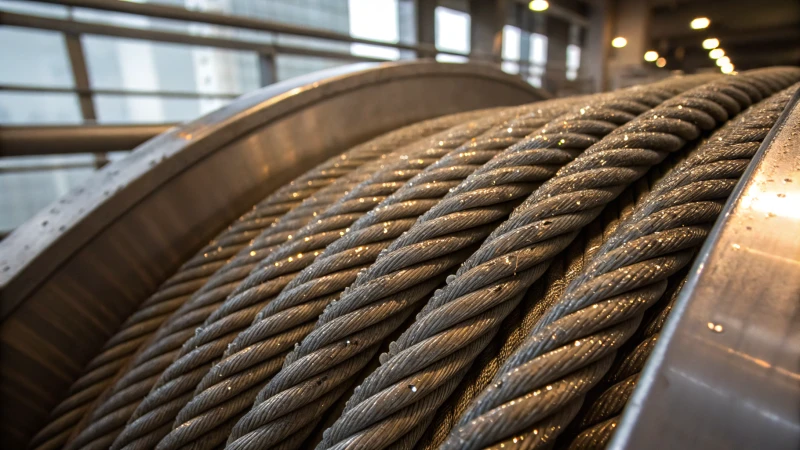
Ever wondered how environmental conditions can mess with something as robust as elevator steel wire ropes?
Environmental factors like temperature, humidity, and salinity can wreak havoc on elevator steel wire ropes. These conditions might lead to corrosion, brittleness, or overheating, ultimately reducing the rope's lifespan and compromising safety.
I remember once stepping into a building only to find the elevator out of order because its steel wire ropes had corroded faster than expected. That experience made me realize how important it is to understand the environment these ropes operate in. Temperature swings can make the ropes brittle, while high humidity—especially with salt in the air—can speed up corrosion. But don't worry, there are ways to protect these vital components. In this article, I'll share practical tips on safeguarding your elevator wire ropes so they can withstand these environmental challenges and keep things running smoothly.
High humidity accelerates steel rope corrosion.True
Humidity increases moisture exposure, leading to faster corrosion of steel.
Salinity has no effect on steel wire ropes.False
Salinity causes rust and deterioration, affecting rope durability.
What Are the Main Environmental Factors Affecting Wire Ropes?
Ever wondered how the weather affects the very ropes that keep cranes and lifts running smoothly?
Humidity, temperature extremes, salinity, and chemical exposure are the main environmental factors affecting wire ropes. These conditions can lead to corrosion, brittleness, and structural weakening, impacting the ropes' performance and lifespan.
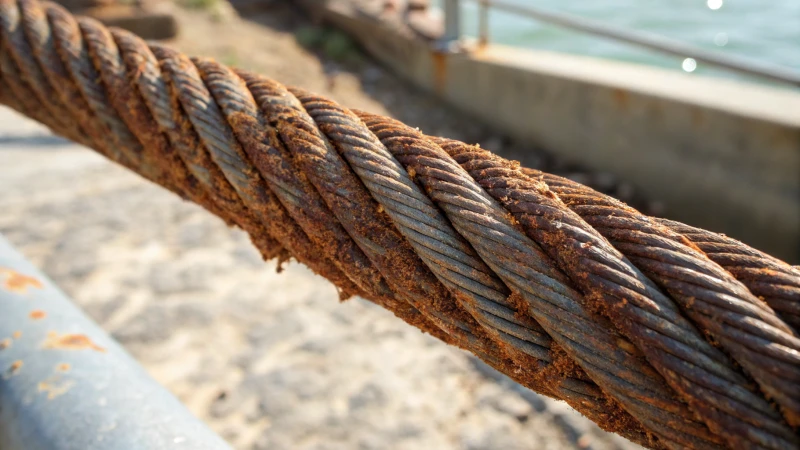
Humidity and Corrosion
You know, one of the most vivid memories I have is standing by the sea on a misty morning, watching massive cranes move effortlessly. But then it hit me—those wire ropes working tirelessly in such a salty environment! Humidity, especially in coastal regions1, fast-tracks corrosion in steel wire ropes. Salt in the air only worsens this, chopping their lifespan drastically. Ever since I realized this, I've advocated for protective coatings like PVC as lifesavers.
| Factor | Impact | Mitigation |
|---|---|---|
| High Humidity | Accelerates corrosion | Use of protective coatings |
| Coastal Salinity | Reduces rope lifespan by 50% | Regular maintenance |
Temperature Extremes
I've felt both the biting chill of winter and the blazing heat of summer on my skin, and I can only imagine what these extremes do to wire ropes. In cold climates, they get brittle—imagine a twig snapping underfoot. On hot days, they lose strength, like pasta left too long in boiling water. That's why I always insist on using temperature-compensating alloys to keep them sturdy no matter the weather.
Salinity and Chemical Exposure
Then there are those wire ropes braving marine environments or handling industrial chemicals. They face a harsh world of salinity and corrosive substances. It's like fighting an uphill battle every day! Stainless steel or galvanized wires become their armor, enhancing durability against such harsh foes.
Understanding these environmental factors is crucial for any application. Take the construction industry, for example—it battles changing weather constantly. That's why temperature-compensating alloys2 are a go-to for ensuring consistent rope performance across different climates.
Managing Environmental Impacts
I've learned that regular inspections and maintenance are non-negotiable for prolonging wire rope life in tough environments. Educating teams about potential environmental threats and equipping them with the right tools makes all the difference.
| Inspection Frequency | Environment Type |
|---|---|
| Weekly | Coastal/High Salinity Areas |
| Monthly | Industrial Chemical Exposure |
| Quarterly | General Construction Areas |
It's not just about keeping operations running smoothly; it's about ensuring safety and efficiency for everyone involved.
Humidity accelerates corrosion in wire ropes.True
Humidity, especially in coastal areas, speeds up corrosion.
Temperature has no effect on wire rope integrity.False
Extreme temperatures can make ropes brittle or weaken them.
How Does Corrosion Impact Steel Wire Ropes in Humid Environments?
I remember the first time I truly understood the impact of corrosion on steel wire ropes; it was a game-changer for our operations.
In humid environments, corrosion significantly weakens steel wire ropes, shortening their lifespan. To combat this, I recommend using corrosion-resistant coatings and choosing stainless steel alloys to improve durability and performance.
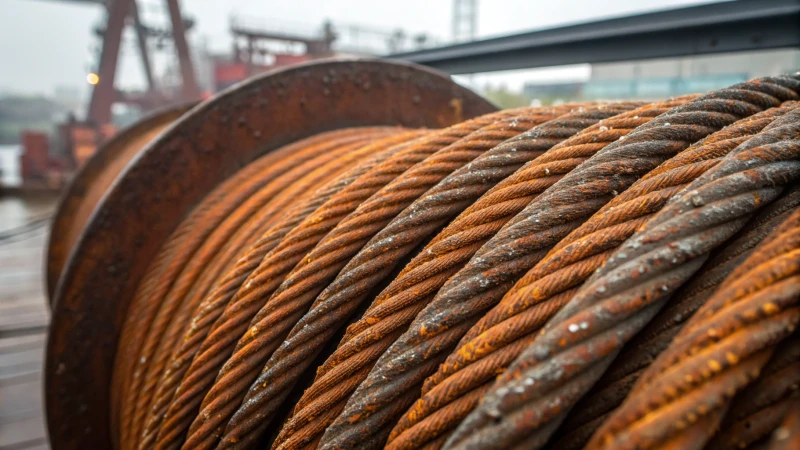
The Science of Corrosion in Humidity
I vividly recall a day at a coastal site where the air was so thick with humidity you could almost taste the salt. It hit me then—this moisture was the silent enemy of our steel wire ropes. Corrosion happens when moisture reacts with the metal surfaces, accelerated by salts3 in coastal or industrial areas, forming rust that slowly eats away at the rope’s strength. Imagine oxidation as a silent dance between water and oxygen, gradually wearing down the metal.
Factors Influencing Corrosion
Several factors play a role in how fast corrosion sets in:
- Humidity Levels: Like a slow-cooking recipe, high moisture content speeds up corrosion.
- Salt Presence: Salt is like the spice that makes this process happen faster.
- Temperature Variations: These are like the chefs turning up the heat, causing expansion and contraction, leading to tiny cracks that expose more metal to corrosion.
| Factor | Impact on Corrosion |
|---|---|
| Humidity | Increases reaction speed |
| Salt | Catalyzes oxidation |
| Temperature | Causes micro-cracks |
Mitigation Strategies
- Material Selection: I’ve found that stainless steel alloys4 are a wise choice because they form a protective chromium layer that stands guard against corrosion.
- Protective Coatings: Using coatings like polyurethane or PVC5 acts as a shield, protecting ropes from direct contact with moisture.
- Regular Maintenance: Just like how regular health check-ups can prevent bigger issues, inspecting and cleaning ropes regularly stops corrosive build-up.
Real-World Applications
In industries like construction or marine, choosing the right steel wire rope is not just about functionality but safety too. I’ve seen firsthand how in coastal construction sites, using galvanized ropes with robust coatings offers extra protection against harsh conditions. For marine operations, specialized anti-corrosion treatments are not just beneficial—they're essential.
By implementing these strategies, not only do we enhance durability but also ensure that operations relying on steel wire ropes run safely and efficiently in humid environments6. This knowledge empowers procurement managers to make informed decisions about materials and preventive measures.
Humidity increases corrosion speed in steel ropes.True
High moisture levels enhance electrochemical reactions, accelerating corrosion.
Salt presence reduces corrosion in steel ropes.False
Salt acts as a catalyst, increasing the rate of oxidation and corrosion.
How Can I Extend the Lifespan of My Ropes?
Ever wondered how to keep your trusty ropes in top shape for years? Dive into my personal rope care journey, packed with practical tips for longevity.
To make ropes last longer, I always store them in cool, dry places away from sunlight, check for any wear and tear regularly, clean off dirt, and use protective coatings. Rope bags or sleeves are my go-to for extra protection.
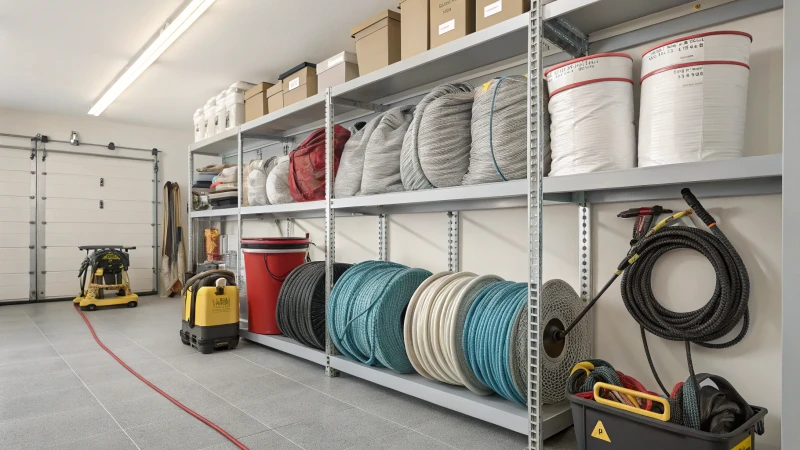
Proper Storage Techniques
I remember my first climbing expedition where my rope got damp and almost unusable. That's when I learned the importance of proper storage. Now, I always keep my ropes in dry, cool places to avoid moisture build-up that can lead to mold. Trust me, temperature control7 is key to preventing brittleness or any degradation.
Regular Inspection Protocols
Routine checks have become a ritual for me. Weekly visual inspections have saved me from potential disasters more than once. I jot down any frayed strands or stiffness in a maintenance log8 to monitor their condition over time. It’s like keeping a health record for your ropes!
| Inspection Checklist | Frequency |
|---|---|
| Visual inspection | Weekly |
| Tactile inspection | Bi-weekly |
| Load testing | Monthly |
Cleaning and Debris Removal
I’ve found that gentle soap and water work wonders for cleaning ropes. Avoiding harsh chemicals is crucial because they can weaken fibers. After a thorough clean, I let them dry completely before putting them away.
Applying Protective Coatings
In my experience, using coatings like polyurethane or PVC adds a protective layer against the elements, especially in humid or marine environments. This step has been a game-changer for maintaining corrosion resistance9.
Use of Rope Bags and Sleeves
I can’t stress enough the importance of rope bags or sleeves for added protection against abrasion and UV exposure. They’ve been particularly useful when I work outdoors, protecting my ropes from accelerated wear.
Implementing Proper Usage Practices
Educating those around me on proper handling techniques has become second nature. Avoiding sharp bends and excessive tension keeps my ropes in peak condition. Periodic training sessions ensure everyone is on the same page about these best practices.
For more detailed guidance, I often consult industry-specific resources and experts who provide tailored advice to suit specific operational needs.
Ropes should be stored in humid environments.False
Storing ropes in dry, cool areas prevents mold and mildew formation.
Regular inspections can extend rope lifespan.True
Inspections help identify wear early, allowing for timely maintenance.
Why are temperature-compensating alloys important for elevators?
Ever wonder what keeps elevators running smoothly despite wild temperature swings?
Temperature-compensating alloys are essential for elevators as they adapt to temperature changes, preserving the materials' structural integrity and ensuring safe, efficient operation by preventing brittleness or expansion.
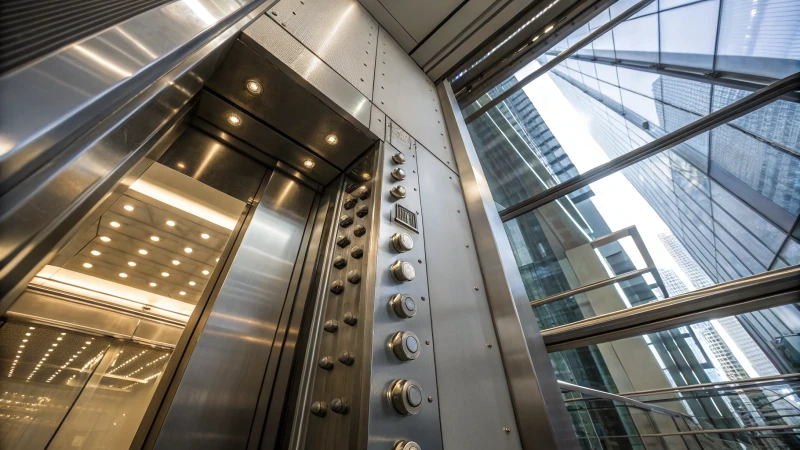
Understanding Temperature Variations
I've always found it fascinating how elevators in places as diverse as the scorching deserts of Arizona and the icy peaks of the Alps manage to work seamlessly. I mean, these are machines that must endure some pretty harsh conditions! Traditional materials tend to expand, contract, or even become brittle when faced with extreme temperatures, which could lead to serious safety issues. That's where temperature-compensating alloys come into play—they're like the unsung heroes of the elevator world, engineered specifically to withstand these environmental stresses effectively10.
How Alloys Work in Elevators
These ingenious alloys adjust their properties in response to temperature shifts. Imagine you're in a chilly mountain lodge and notice that your elevator runs just as smoothly as it did back in your sweltering hometown. That's thanks to certain alloys11 that can expand slightly when cold, which keeps the tension in those all-important steel ropes. This adaptability is crucial—it helps avoid problems like slack or increased wear that could otherwise wreak havoc on performance.
| Temperature | Impact on Materials | Alloy Solution |
|---|---|---|
| High | Expansion, weakening | Compensates by tightening or stiffening |
| Low | Contraction, brittleness | Expands slightly to maintain tension |
Benefits of Using Temperature-Compensating Alloys
- Safety: Consistent performance reduces the risk of mechanical failure12, a relief for anyone who's ever been stuck between floors!
- Durability: These alloys boost the lifespan of elevator components by minimizing stress-induced wear, ensuring you don't have to replace parts frequently.
- Efficiency: Elevators maintain optimal function without the need for constant maintenance adjustments, which is music to any building manager's ears.
Real-World Applications
In skyscrapers around the globe, especially those in regions with severe temperature fluctuations, the safety and longevity of elevators depend heavily on such material innovations13. Understanding the types of temperature-compensating alloys can be a game-changer for procurement managers like John and Emma, helping them choose materials that not only fit their budgets but also ensure long-term reliability.
Temperature-compensating alloys prevent elevator rope slack.True
These alloys adapt to temperature changes, maintaining tension in ropes.
Elevators in deserts don't need temperature-compensating alloys.False
Desert climates cause expansion; alloys are crucial to manage this stress.
Conclusion
Environmental conditions like humidity, temperature, and salinity significantly impact the performance of elevator steel wire ropes, leading to corrosion and brittleness, necessitating protective measures for longevity.
-
Explore how humidity influences wire rope corrosion and learn effective prevention methods. ↩
-
Learn about alloys that maintain wire rope integrity across temperature extremes. ↩
-
Understanding how salt accelerates corrosion helps in choosing materials and coatings that withstand salty environments. ↩
-
Stainless steel alloys offer superior resistance to corrosion, making them ideal for humid conditions. ↩
-
Exploring different protective coatings helps in selecting the best option to prevent corrosion. ↩
-
Identifying challenges aids in developing strategies to counteract corrosion's effects. ↩
-
Learn how to maintain optimal storage conditions for ropes to prevent damage from temperature extremes. ↩
-
Understand why keeping a detailed maintenance log is crucial for tracking rope condition and enhancing longevity. ↩
-
Explore top coating options that protect ropes from corrosion, especially in harsh environments. ↩
-
Explore how these alloys adapt to temperature changes, ensuring safety and efficiency. ↩
-
Learn about specific alloy types and their unique properties. ↩
-
Understand how these alloys enhance elevator safety and reduce risks. ↩
-
See where these alloys are used globally and their impact. ↩

